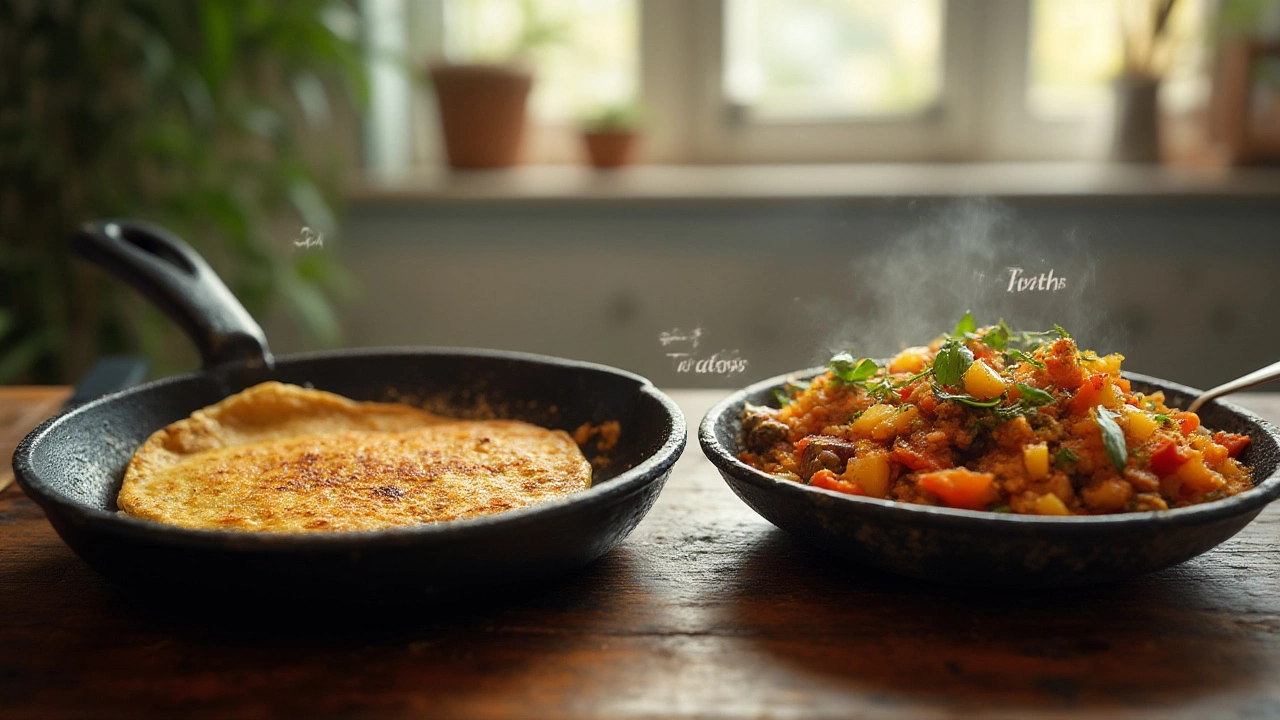Cheap vs Expensive Cast Iron: What Really Sets Them Apart?

Hold up before you hit 'buy now' on that cast iron skillet just because it’s on sale—or before you splurge on a high-end pan thinking it will transform you into the next Gordon Ramsay overnight. The truth is, there’s a storm of opinions swirling around whether cheap and expensive cast iron cookware are all that different. People swap stories about grandmas frying eggs with ancient bargain pans and others romanticize artisan skillets from tiny foundries. But at the end of the day, what actually sets them apart isn’t just the price tag or a fancy brand name. Ready to break through the hype?
What Makes Cast Iron, Well, Cast Iron?
If you've ever held a cast iron pan, you know these things are a workout just carrying them from the cupboard to the stove. But whether you’re looking at a bargain skillet from a supermarket or a handcrafted piece from a trendy brand, they’re both made from melted iron poured into a mold (that’s why it’s called "cast" iron). Simple, right?
But there are some real differences worth picking apart. It starts with the iron itself. Cheap cast iron often uses recycled metal. Expensive brands sometimes boast about sourcing virgin iron, claiming it creates a more reliable product, yet there isn't much evidence proving virgin iron truly cooks better. The real core of the difference often lies in the sand molds used in casting. High-end skillets are usually finished more carefully, so they feel smoother to the touch. Cheaper pans? They can be rough, gritty, occasionally even pitted.
Another factor is weight. Both cheap and expensive cast iron are heavy, but some budget options are even bulkier due to thicker walls meant to compensate for lower-quality casting. The trade-off is, heavier doesn’t always mean better. Some classic brands, like those old-school American Griswolds found at flea markets, are thinner and lighter, but still legendary for performance. So pay attention to the feel and heaviness that suits your cooking style instead of just assuming one is always superior.
And get this: While cast iron was basically cheap as chips a hundred years ago, it’s gotten trendy. That means some brands put on a high price tag mainly for design and marketing, not always function.
Performance in Real Kitchens: Does Price Equal Results?
This is where things get real for home cooks. It’s easy to assume that expensive cast iron will outperform a budget pan in every situation, but the line isn’t so clear. Both cheap and high-end pans can make your steak sizzle or crisp your roast potatoes beautifully under the right conditions. The most dramatic difference often pops up right out of the box—literally.
Expensive cast iron is usually pre-seasoned more thoroughly. This means it arrives with a slick, black non-stick coating built up by layers of baked-on oil. That makes cleanup easier and stops eggs from sticking like glue on your first go. Cheap pans? Sometimes they arrive with just a single thin coat, or even just a bit of waxy coating to prevent rust, so you may need to season them a couple of times yourself to get started. But after some good seasoning and a few weeks of regular use, cheap pans typically catch up.
Another surprise: Heat retention isn’t wildly different between budget and premium pans, unless the thickness varies. All cast iron holds heat like a champ—you have to let them warm up properly for best results. A smooth, well-finished surface on an expensive skillet can make flipping pancakes easier, while cheaper pans with rough surfaces may make eggs stick or catch. But even rough pans smooth out after regular cooking, as the seasoning builds up and fills in those micro-pits and bumps.
Cast iron cookware has one universal trait: its bulletproof durability. The thing most likely to damage a pan is user neglect (like forgetting to dry or season it, leading to rust), not the price bracket. Plenty of folks in Manchester cook on thrift-store pans that have been with them longer than their cars. It’s more about maintenance than money spent.
Here’s a side-by-side comparison of typical features:
| Feature | Cheap Cast Iron | Expensive Cast Iron |
|---|---|---|
| Material | Often recycled iron | Sometimes virgin iron |
| Finish | Rough, needs seasoning | Smooth, pre-seasoned |
| Weight | Can be very heavy | Usually balanced design |
| Longevity | Decades with care | Decades or longer |
| Cost | £15-£30 average | £80-£250 or more |

The Seasoning Secret: Can You Turn a Cheap Pan Into a Premium Performer?
Here’s the wild thing: with a bit of effort, most cheap cast iron receives the same love from your stovetop as a swanky £200 pan. The process is called seasoning—basically baking on thin layers of oil until the surface shines and turns virtually non-stick. High-end brands, like Le Creuset or Field Company, send their pans out with gorgeous, ready-to-go coats of seasoning. Budget brands from the supermarket may come bone-dry or just lightly oiled. But that’s not the end of the road.
If you’re willing to put in a lazy Saturday afternoon with your oven (and maybe annoy your flatmates with a bit of smoke), you can season even the cheapest pan until it feels and performs like something much pricier. A popular hack involves using flaxseed oil for its hard finish—just apply a thin layer, bake at high heat (250°C or 480°F) for an hour, let it cool, repeat three or four times. Each round fuses the oil to the iron, building up a sleek, black surface. This makes cleaning easy and stops food from sticking. The more you cook with the pan, the better it gets. Cheap cast iron is a blank slate. Use it for bacon, test your Yorkshire pudding, try one-pan cornbread bakes—the seasoning will keep improving.
There’s good science behind it too: a study from America’s Test Kitchen found even basic, rough-surfaced pans smoothed out after six months of home use. The key is patience, and never scrubbing off the seasoning with harsh detergents. Just hot water, a gentle scrub with some salt, and re-oiling before storage will keep both cheap and expensive pans in top form for decades. That’s why, if you stumble on a rusting pan at a car boot sale, grab it. You can bring it back to life in a weekend, no matter what it originally cost.
- Always dry your cast iron right after washing. Moisture is the enemy of good seasoning.
- Want more non-stick magic? Cook fatty foods (bacon, sausages) early on in a new pan.
- If you ever notice rust, scrub it with steel wool and re-season. It’s as simple as that.
Buying Tips: Snagging the Best Cast Iron for Your Money
So, which should you choose? It depends on your priorities in the kitchen, your patience for a DIY project, and, let’s be honest, your wallet. If you love the idea of owning something unique, heirloom-quality, or made in England with artisan care, you’ll probably enjoy a splurge. But if your goal is just to get cracking with Sunday fry-ups or homemade pizza, cheap cast iron has your back.
Here are a few things to check before you buy, regardless of price:
- Test the handle. Fancy pans often have more ergonomic grips that don’t feel like they’ll snap your wrist, but some budget pans are just as practical.
- Study the interior. Smooth, polished cooking surfaces are easier for eggs, pancakes, and delicate stuff. But a rough surface isn’t a disaster if you don’t mind seasoning it well.
- Flatness is essential. Uneven pans spin on the hob, making them impossible to cook evenly. Lay a straight edge across the bottom at the shop if you can.
- Think about size. Classic 10-12 inch skillets work for most meals, but mini-pans make great individual Yorkshire puddings or the world’s best chocolate chip cookies.
And don’t get starry-eyed over collectible brands, unless you’re genuinely into vintage gear. Prices skyrocket for rare logos and markings, but food cooked in a no-name pan still tastes as good. More and more, people are finding second-hand skillets at charity shops or car boot sales. Clean off the rust, go through a round or two of seasoning, and it will sing just as well as a brand-new pan. There’s a whole online community obsessed with rescuing old cast iron—worth exploring if you love a project.
A final curveball: Cast iron isn’t good for every cooking job. Highly acidic foods, like tomato sauce, can strip away the seasoning. And unless you’re confident in your grip, beware of handling hot cast iron one-handed—they’re no joke for the wrist.
So, expensive cast iron offers some perks—slicker finish, prestige, maybe a great backstory. But with effort, a cheap pan becomes an all-star in your kitchen arsenal. Whether you spend £20 or £200, the best cast iron is the one that gets used, loved, and seasoned—by you.